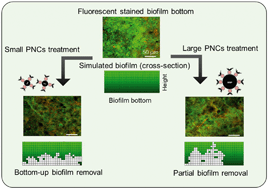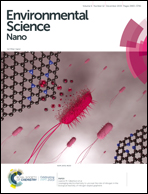Bottom-up biofilm eradication using bacteriophage-loaded magnetic nanocomposites: a computational and experimental study†
Abstract
Biofilms cause a variety of pervasive problems in water treatment, distribution and reuse systems that are difficult to mitigate due to their resistance to disinfectants. We used magnetic phage-nanocomposite conjugates (PNCs) to target bacteria in biofilm inner layers for bottom-up eradication. Polyvalent Podoviridae phages PEB1 (54 nm) or PEB2 (86 nm) were covalently conjugated (via amide bonds) with magnetic colloidal nanoparticle clusters (CNCs) of different sizes (150, 250 or 500 nm). Smaller CNCs with higher density of amino groups loaded phages more efficiently than the largest CNCs (e.g., for PEB1, 60 ± 4, 62 ± 5, and 47 ± 4 phages were loaded per μm2). Smaller PNCs dispersed phages more evenly throughout the biofilm bottom, significantly disrupting the biofilm bottom layer and detaching the biofilm within 6 h. The biofilm removal efficiency was 98.3 ± 1.4% for dual species biofilm (i.e., Escherichia coli and Pseudomonas aeruginosa) and 92.2 ± 3.1% for multi-species biofilm (i.e., E. coli, P. aeruginosa, and non-hosts Bacillus subtilis and Shewanella oneidensis). Large PNCs caused higher physical disruption but lower corresponding removal efficiencies (i.e., 80.2 ± 3.4% for dual species biofilm and 67.6 ± 3.8% for multi-species biofilm) due to lower horizontal diffusion at the bottom of the biofilm. A semi-empirical numerical model corroborated the higher biofilm removal efficiency with smaller PNCs and inferred that PNC size influences the mode of phage propagation: Small PNCs facilitate biofilm bottom clearance with significant horizontal dispersion while large PNCs mainly enhance vertical propagation. Overall, this study demonstrates the importance of size control to enhance the biofilm eradication capability of PNCs as an alternative or complementary biofilm control strategy.

- This article is part of the themed collection: Best Papers 2019 – Environmental Science: Nano


 Please wait while we load your content...
Please wait while we load your content...
